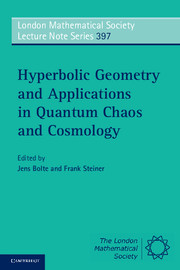Book contents
- Frontmatter
- Contents
- List of Contributors
- Preface
- I Hyperbolic Geometry
- II Selberg's Trace Formula: An Introduction
- III Semiclassical Approach to Spectral Correlation Functions
- IV Transfer Operators, the Selberg Zeta Function and the Lewis-Zagier Theory of Period Functions
- V On the Calculation of Maass Cusp Forms
- VI Maass Waveforms on (Γ0(N), χ) (Computational Aspects)
- VII Numerical Computation of Maass Waveforms and an Application to Cosmology
- Index
- References
III - Semiclassical Approach to Spectral Correlation Functions
Published online by Cambridge University Press: 05 January 2012
- Frontmatter
- Contents
- List of Contributors
- Preface
- I Hyperbolic Geometry
- II Selberg's Trace Formula: An Introduction
- III Semiclassical Approach to Spectral Correlation Functions
- IV Transfer Operators, the Selberg Zeta Function and the Lewis-Zagier Theory of Period Functions
- V On the Calculation of Maass Cusp Forms
- VI Maass Waveforms on (Γ0(N), χ) (Computational Aspects)
- VII Numerical Computation of Maass Waveforms and an Application to Cosmology
- Index
- References
Summary
Introduction
One motivation for deriving semiclassical methods for chaotic systems like the Gutzwiller trace formula was to find a substitute for the EBK quantisation rules which provide semiclassical approximations for energy levels and wave functions in integrable systems [1]. Although the Gutzwiller trace formula allows to determine energy levels semiclassically from a knowledge of classical periodic orbits, in practise only a relatively small number of the lowest energies can be determined in this way due to the exponential proliferation of the number of long periodic orbits in chaotic systems.
However, the trace formula is very powerful in applications in which one is interested not in individual levels, but in statistical properties of the spectrum in the semiclassical regime. These spectral statistics are in the centre of interest in quantum chaos, because they are found to be universal and to provide a clear signature for chaos in the underlying classical system. All numerical evidence points to an agreement of spectral statistics in generic chaotic systems with those of random matrix theory (RMT) [2]. The aim of the semiclassical method is to find a theoretical explanation and, possibly, a proof for this connection between quantum chaos and random matrix theory. Similarly as on the quantum side, what is needed for this task is not a knowledge of individual periodic orbits, but of statistical properties of long periodic orbits.
The first steps in this direction were made in the seminal works of Hannay and Ozorio de Almeida, and Berry.
- Type
- Chapter
- Information
- Publisher: Cambridge University PressPrint publication year: 2011

